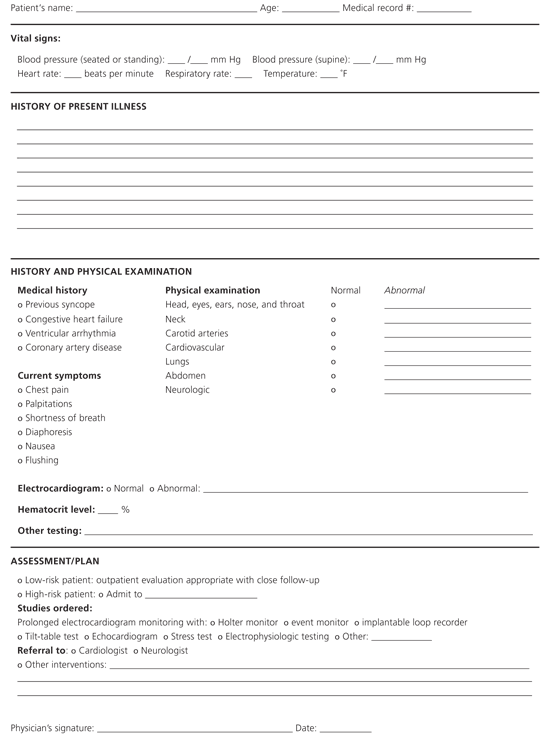
Am Fam Physician. 2006;74(8):1367-1370
Clinical Question
What is the prognosis and recommended initial evaluation for a patient with syncope?
Evidence Summary
Although syncope often is benign, it may have a serious underlying cause. An important question for primary care or emergency department physicians is whether the patient can be evaluated safely in the outpatient setting. Two clinical risk scores that can assist physicians in making this decision have been developed and validated. Both require electrocardiography (ECG) and a focused patient history and physical examination (see accompanying patient encounter form).

The first syncope rule (Table 11) was developed using prospective data collected from two groups of patients presenting to the emergency department with syncope between 1981 and 1991.1 All patients underwent a standardized assessment that included blood tests, prolonged ECG monitoring, and other studies that the treating physicians considered necessary. Four independent predictors of serious arrhythmia or death after one year were identified: abnormal ECG, age older than 45 years, history of congestive heart failure, and history of ventricular arrhythmia. Sinus bradycardia or tachycardia or nonspecific ST- or T-wave changes alone were not considered abnormal. The rule was developed in 251 patients and prospectively validated in 374 patients. The risk of death in the year after presentation ranged from 1 percent for patients with no risk factors to 27 percent for patients with three or more risk factors.1
| Risk factors |
| Abnormal electrocardiogram* |
| Age older than 45 years |
| History of congestive heart failure |
| History of ventricular arrhythmia |
The San Francisco Syncope Rule (Table 22) was developed to identify patients at risk of serious outcomes (e.g., death, myocardial infarction, significant hemorrhage, pulmonary embolism, arrhythmia, stroke) within 30 days of presentation.2 The authors validated the rule with prospective data from a second group of 713 patients presenting to the emergency department with syncope. Patients with alcohol- or drug-related loss of consciousness, trauma, or definite seizure were excluded. The mean age of patients was 61 years, and 53 had a serious outcome during the 30-day follow-up. Five risk factors were identified: systolic blood pressure less than 90 mm Hg, shortness of breath, nonsinus rhythm or new changes present on ECG, history of congestive heart failure, and a hematocrit level less than 30 percent. Patients with any one risk factor had a 15.2 percent risk of serious outcome compared with a 0.3 percent risk for patients with no risk factors.2
| Risk factors |
| Systolic blood pressure less than 90 mm Hg |
| Shortness of breath |
| Electrocardiogram: nonsinus rhythm or new changes present |
| History of congestive heart failure |
| Hematocrit level less than 30 percent |
Two evidence-based guidelines address the initial evaluation of patients with syncope.3,4 The American College of Emergency Physicians (ACEP) recommends that patients older than 60 years with a history of cardiovascular disease or evidence of heart failure or cardiac outflow obstruction be considered at high risk of adverse outcomes.3 Patients younger than 45 years without cardiovascular disease or other risk factors should be considered at low risk. The ACEP recommends ECG if a history and physical examination do not reveal a diagnosis.3 The European Society of Cardiology recommends a similar evaluation and provides guidance regarding clinical symptoms that suggest specific causes of syncope (Table 3).4
| Type of syncope | Clinical features |
|---|---|
| Neurally mediated (vasovagal) | Absence of cardiovascular disease |
| Long history of syncope episodes | |
| Syncope occurs after sudden, unexpected, or unpleasant sight, sound, smell, or pain | |
| Syncope occurs during prolonged standing, especially in crowded or hot places | |
| Nausea or vomiting associated with syncope | |
| Syncope occurs during a meal or in the absorptive state after a meal | |
| Syncope occurs with head rotation or when there is pressure on carotid sinus (e.g., tumor, shaving, tight collar) | |
| Syncope occurs after exertion | |
| Cerebrovascular | Syncope occurs with arm exercise |
| Blood pressure or pulse difference between the two arms | |
| Orthostatic-hypotension related | Syncope occurs after standing up |
| Temporal relationship with start of medication causing hypotension or dosage changes | |
| Syncope occurs during prolonged standing, especially in crowded or hot places | |
| Presence of autonomic neuropathy or parkinsonism | |
| Syncope occurs after exertion | |
| Cardiac | Presence of definite structural heart disease |
| Syncope occurs during exertion or when supine | |
| Syncope preceded by palpitation | |
| Family history of sudden death |
Applying the Evidence
A 68-year-old man presents in your office after an episode of syncope. He had just dressed for a special event and was wearing a tie for the first time in many years. The patient was nauseated and felt flushed after rising from the toilet, then his wife saw him fall to the floor. There was no seizure activity, and he regained consciousness within 15 seconds. He vomited once but felt somewhat better after drinking something and resting; he refused transport to the emergency department. He comes to your office the next day “to make sure nothing serious is wrong.” He denies any history of previous arrhythmia, heart failure, or heart disease, and he had no shortness of breath during the episode. He has normal blood pressure, cardiac examination, and ECG. His hematocrit level is 42 percent. What is his risk of short- and long-term adverse outcomes?
Answer: The patient only has one risk factor (his age) for one-year mortality and no risk factor for serious outcomes within 30 days of presentation. His symptoms suggest neurally mediated (vasovagal) syncope. You discuss this with the patient, and the two of you decide that no further evaluation is required at this time. If his symptoms recur or he develops additional symptoms, he agrees to see you immediately.